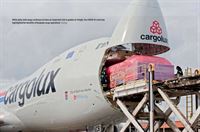Фотографии
-
Many analysts believe widebody P2F aircraft will become a more common sight in the coming decade
Самолёты на фотографии: Boeing Boeing 777 - США - 1994
-
Passenger-to-freighter (P2F) options have become more affordable since the onset of the COVID-19 crisis EFW
Самолёты на фотографии: Airbus A330 - International - 1992
-
The upper frame shell of an Airbus A330-200P2F
Самолёты на фотографии: Airbus A330 - International - 1992
-
Регистрационный номер: D-ANJA, VH-ULD The world's first Airbus A321P2F (passenger-to-freighter) jet is due to join Qantas Freight imminently. The pioneering 1998-built airframe, VH-ULD (c/n 835) - originally delivered to British Midland - will fly on behalf of Australia Post. According to Qantas Freight, the A321P2F is mooted to add ten tons of capacity, an increase of more than 50% over its Classic 737 freighters
Самолёты на фотографии: Airbus A321 - International - 1993
-
The first Airbus A321P2F landing following its maiden flight
Самолёты на фотографии: Airbus A321 - International - 1993
-
Регистрационный номер: VQ-BLR Manufacturers, such as Boeing, continue to develop new-build cargo jets for customers around the world. This example, VQ-BLR (c/n 37668), was the second 747-8F to be delivered to AirBridgeCargo Airlines.
Самолёты на фотографии: Boeing Boeing 747-8 - США - 2010
-
Outsize load carrying capacity is one advantage of the 747-8F, according to Cargolux.
The nose cargo door is one of the 747 Freighter's distinguishing features.
While belly hold cargo continues to have an important role in global air freight, the COVID-19 crisis has highlighted the benefits of bespoke cargo operations.Самолёты на фотографии: Boeing Boeing 747-8 - США - 2010
-
A Boeing 737-800SF undergoing modification at Commercial Jet's Miami facility
Самолёты на фотографии: Boeing Boeing 737-600 / BBJ - США - 1998
-
The US-built narrowbody continues to be a hugely popular model for passenger operations
Самолёты на фотографии: Boeing Boeing 737-600 / BBJ - США - 1998
-
Регистрационный номер: N916SC Боинг 737-800BDSF, переделанный израильской фирмой IAI из обычного пассажирского самолета
Israel Aerospace Industries' 737-800BDSF is the third conversion option to become available for the 737-800.
Among the most visible modifications made to P2F airframes is the removal of most of the windows in the former passenger cabinСамолёты на фотографии: Boeing Boeing 737-600 / BBJ - США - 1998
Статьи
- Bronco II /Concept Insight/
- Focus: UAV, Rotary, Business, Technology, GA
- News: Commercial, Military
- A.Mladenov - Russia's 'old man of the sea' returns /Russian Review/
- B.Taghvaee - Wings of hope
- C.McCormic, A.Mehta - The changing face of Philadelphia
- F.Friz - Germany's SAR successor
- G.Smith, Z.Hrnkova - Testing turboprop resilense
- H.-P.Grolleau - Phenix rising
- I.Harbison - Conversion kicks
- M.Broadbent - Middle Eastern promise
- P.Eden - Long live the King!
- P.Eden, F.Lemos - Crafting perfection
- S.Rivas - Pampas head for higher ground
- S.Rivas, J.Moralez - Pelicans in pursuit
- S.van Roij - Dutch masters









